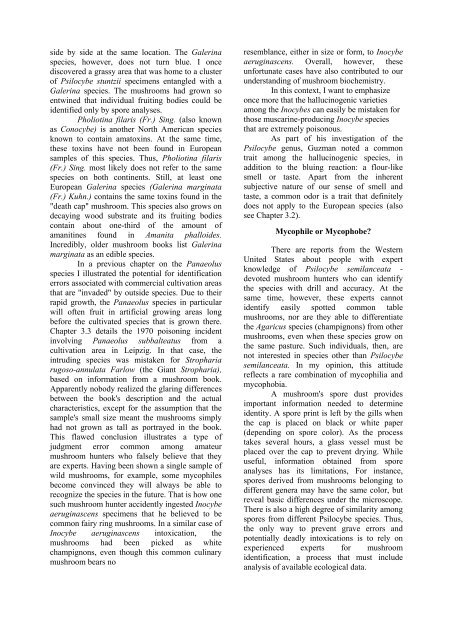Jochen Gartz - Magic Mushrooms Around the ... - preterhuman.net
Jochen Gartz - Magic Mushrooms Around the ... - preterhuman.net
Jochen Gartz - Magic Mushrooms Around the ... - preterhuman.net
Create successful ePaper yourself
Turn your PDF publications into a flip-book with our unique Google optimized e-Paper software.
side by side at <strong>the</strong> same location. The Galerina<br />
species, however, does not turn blue. I once<br />
discovered a grassy area that was home to a cluster<br />
of Psilocybe stuntzii specimens entangled with a<br />
Galerina species. The mushrooms had grown so<br />
entwined that individual fruiting bodies could be<br />
identified only by spore analyses.<br />
Pholiotina filaris (Fr.) Sing. (also known<br />
as Conocybe) is ano<strong>the</strong>r North American species<br />
known to contain amatoxins. At <strong>the</strong> same time,<br />
<strong>the</strong>se toxins have not been found in European<br />
samples of this species. Thus, Pholiotina filaris<br />
(Fr.) Sing. most likely does not refer to <strong>the</strong> same<br />
species on both continents. Still, at least one<br />
European Galerina species (Galerina marginata<br />
(Fr.) Kuhn.) contains <strong>the</strong> same toxins found in <strong>the</strong><br />
"death cap" mushroom. This species also grows on<br />
decaying wood substrate and its fruiting bodies<br />
contain about one-third of <strong>the</strong> amount of<br />
amanitines found in Amanita phalloides.<br />
Incredibly, older mushroom books list Galerina<br />
marginata as an edible species.<br />
In a previous chapter on <strong>the</strong> Panaeolus<br />
species I illustrated <strong>the</strong> potential for identification<br />
errors associated with commercial cultivation areas<br />
that are "invaded" by outside species. Due to <strong>the</strong>ir<br />
rapid growth, <strong>the</strong> Panaeolus species in particular<br />
will often fruit in artificial growing areas long<br />
before <strong>the</strong> cultivated species that is grown <strong>the</strong>re.<br />
Chapter 3.3 details <strong>the</strong> 1970 poisoning incident<br />
involving Panaeolus subbalteatus from a<br />
cultivation area in Leipzig. In that case, <strong>the</strong><br />
intruding species was mistaken for Stropharia<br />
rugoso-annulata Farlow (<strong>the</strong> Giant Stropharia),<br />
based on information from a mushroom book.<br />
Apparently nobody realized <strong>the</strong> glaring differences<br />
between <strong>the</strong> book's description and <strong>the</strong> actual<br />
characteristics, except for <strong>the</strong> assumption that <strong>the</strong><br />
sample's small size meant <strong>the</strong> mushrooms simply<br />
had not grown as tall as portrayed in <strong>the</strong> book.<br />
This flawed conclusion illustrates a type of<br />
judgment error common among amateur<br />
mushroom hunters who falsely believe that <strong>the</strong>y<br />
are experts. Having been shown a single sample of<br />
wild mushrooms, for example, some mycophiles<br />
become convinced <strong>the</strong>y will always be able to<br />
recognize <strong>the</strong> species in <strong>the</strong> future. That is how one<br />
such mushroom hunter accidently ingested Inocybe<br />
aeruginascens specimens that he believed to be<br />
common fairy ring mushrooms. In a similar case of<br />
Inocybe aeruginascens intoxication, <strong>the</strong><br />
mushrooms had been picked as white<br />
champignons, even though this common culinary<br />
mushroom bears no<br />
resemblance, ei<strong>the</strong>r in size or form, to Inocybe<br />
aeruginascens. Overall, however, <strong>the</strong>se<br />
unfortunate cases have also contributed to our<br />
understanding of mushroom biochemistry.<br />
In this context, I want to emphasize<br />
once more that <strong>the</strong> hallucinogenic varieties<br />
among <strong>the</strong> Inocybes can easily be mistaken for<br />
those muscarine-producing Inocybe species<br />
that are extremely poisonous.<br />
As part of his investigation of <strong>the</strong><br />
Psilocybe genus, Guzman noted a common<br />
trait among <strong>the</strong> hallucinogenic species, in<br />
addition to <strong>the</strong> bluing reaction: a flour-like<br />
smell or taste. Apart from <strong>the</strong> inherent<br />
subjective nature of our sense of smell and<br />
taste, a common odor is a trait that definitely<br />
does not apply to <strong>the</strong> European species (also<br />
see Chapter 3.2).<br />
Mycophile or Mycophobe<br />
There are reports from <strong>the</strong> Western<br />
United States about people with expert<br />
knowledge of Psilocybe semilanceata -<br />
devoted mushroom hunters who can identify<br />
<strong>the</strong> species with drill and accuracy. At <strong>the</strong><br />
same time, however, <strong>the</strong>se experts cannot<br />
identify easily spotted common table<br />
mushrooms, nor are <strong>the</strong>y able to differentiate<br />
<strong>the</strong> Agaricus species (champignons) from o<strong>the</strong>r<br />
mushrooms, even when <strong>the</strong>se species grow on<br />
<strong>the</strong> same pasture. Such individuals, <strong>the</strong>n, are<br />
not interested in species o<strong>the</strong>r than Psilocybe<br />
semilanceata. In my opinion, this attitude<br />
reflects a rare combination of mycophilia and<br />
mycophobia.<br />
A mushroom's spore dust provides<br />
important information needed to determine<br />
identity. A spore print is left by <strong>the</strong> gills when<br />
<strong>the</strong> cap is placed on black or white paper<br />
(depending on spore color). As <strong>the</strong> process<br />
takes several hours, a glass vessel must be<br />
placed over <strong>the</strong> cap to prevent drying. While<br />
useful, information obtained from spore<br />
analyses has its limitations, For instance,<br />
spores derived from mushrooms belonging to<br />
different genera may have <strong>the</strong> same color, but<br />
reveal basic differences under <strong>the</strong> microscope.<br />
There is also a high degree of similarity among<br />
spores from different Psilocybe species. Thus,<br />
<strong>the</strong> only way to prevent grave errors and<br />
potentially deadly intoxications is to rely on<br />
experienced experts for mushroom<br />
identification, a process that must include<br />
analysis of available ecological data.








![The Big Lie 9-11 and Government Complicity in Mass Murder [PDF]](https://img.yumpu.com/50957077/1/190x245/the-big-lie-9-11-and-government-complicity-in-mass-murder-pdf.jpg?quality=85)








